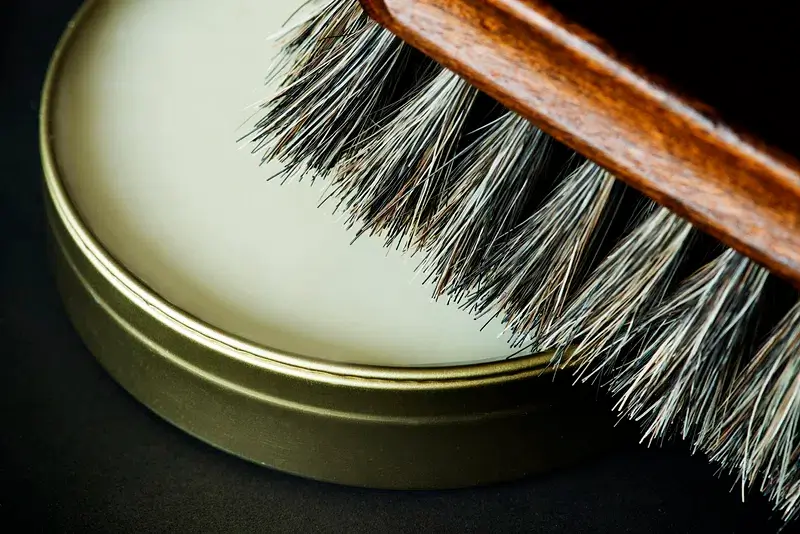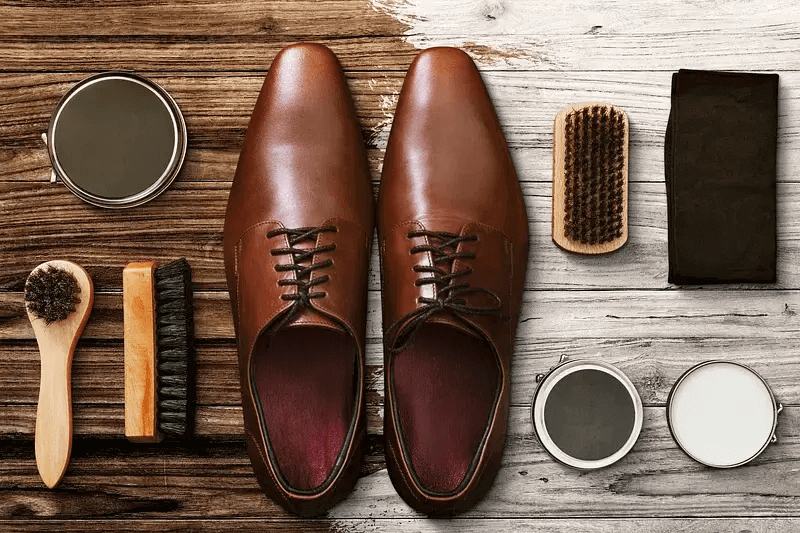Once you own a nice pair of boots, we’re sure you’ll want to polish and keep them looking their best, but what’s the best way to do this?
Whether you’re wearing your favorite pair of Chelsea boots, work boots, or cowboy boots, giving them a regular polish is an essential part of maintaining their appearance and extending their lifespan.
Polishing your boots not only ensures they still look stylish over time but also helps to protect and preserve the leather, so they last in your wardrobe for longer. If you don’t know how to polish your boots, read our simple step-by-step process to keep your boots maintained and cared for.
What Do You Need for Boot Polish?
Before you take off your boots and get started, you’ll need to gather the necessary tools and materials. These include:
- Soft-bristle brush.
- Soft cloth or rag.
- Shoe polish or wax.
- Applicator brush.
- Horsehair brush.
Once you’ve gathered your tools, there are a few common mistakes you must avoid to ensure your boots look their best and don’t show signs of wear and tear.
5 Common Mistakes When Polishing Boots
If you want to avoid unsatisfactory results or damaging your footwear, there are a few common errors to watch out for.
Mirror shining your brand-new boots
It’s important that when your boots are fresh out of the box, you don’t get to work polishing them straight away. After the shoe production process, there are still chemicals in the natural pores of your boot’s leather.
This is why adding a mirror shine to your new boots straight away can remove the finish from the material and even cause permanent damage. So, make sure you wear your boots before polishing them.
Using too much polish
Applying too much polish can create a thick, sticky layer on the surface of your boots that won’t properly absorb into the leather. It may also lead to an uneven finish and make the boots appear dull or greasy.
Never polish too fast
You need to have patience when polishing your boots. If you polish too fast, this will lead to poorer results and can potentially damage the leather. Take your time and make sure you’re covering the entire surface of your shoes.
Not letting your boots dry
Rushing the polish’s drying time can prevent it from properly bonding with the leather. Allow each coat of polish to dry thoroughly before buffing to get the best results.
Using the wrong polish
Some polishes don’t react well to some leathers, so always read the packaging to check you have the right polish. Specific boot polish brands may have unique instructions and recommendations, so always refer to the product’s label or the manufacturer’s guidelines for the best results.
Now you know some common mistakes to avoid. Here is a step-by-step guide to polishing your boots to ensure they look their best, avoid wear and tear, and maintain their fresh-out-the-box shine.

Ste-by-Step Guide: How to Polish Boots
Step 1: Clean the boots
The first step is to make sure there is no dust, dirt or other debris on your boots before you apply any polish. Remove the laces and use your clean soft cloth or a soft-bristle brush to clean the leather. You may need to dampen the cloth with a few drops of water but try not to get your boots too wet.
If your boots have a tall neck, a simple tip that makes the cleaning and polishing process easier is to place a rolled-up towel in the boot. Once you’ve completely cleaned your boots, you may need to be patient as it’s essential they’re dry before you apply any polish.
Step 2: Test the polish
Before applying the polish directly to your boots, do a small test on a discreet area, such as the tongue or inside the shaft, to ensure that the color matches your boots.
You should also double check the polish’s packaging to ensure it’s the right product for your boots’ leather.
Step 3: Apply the polish oil
Take a small amount of shoe polish on an applicator brush or wrap a piece of clean cloth around your finger and apply the polish to one section of the boot in small, circular motions.
Work your way across every part of the boot, making sure to apply the polish evenly. Use gentle pressure and ensure that the polish gets into all the creases and seams.
Take your time and remember not to rub the boots too quickly or excessively. This is the step when you should start seeing results, but remember the polish will need to dry before your boots will look their best.
Step 4: Let the polish dry
Put your feet up and allow the polish to dry completely according to the instructions on the product. This usually takes a few minutes. While your boots are drying, make sure you avoid touching them to prevent any smudging.
Step 5: Buff the boots
Use a horsehair brush to vigorously buff the boots once the polish is completely dry. Use long, smooth strokes in the direction of the leather grain to bring out a lustrous shine. Make sure you continuously check the material to see if you’ve achieved your desired level of shine and ensure the leather is in good condition.
Step 7: Achieve a Perfect Shine
Once you’re satisfied with the shine, wipe the boots with a clean cloth to remove any excess polish residue. You can use a soft cloth or a brush to gently wipe away any excess polish and buildup from the boots. To remove stubborn residue, use a damp cloth or a leather cleaner.
If you’re not happy with how they’re looking, you can repeat the polishing process again; however, you must make sure the boots are completely dry and there’s no excess polish on the leather.
By following these steps and taking your time with each boot, you can achieve a professional and glossy finish that keeps your boots in excellent condition and looking great for years to come.
Alternative Methods For Boots Polishing
There’s more than one way to polish your boots. While our comprehensive guide explains the most effective way, if you’re short on time or don’t have the recommended materials, there are some alternative methods.
Here are a couple of alternatives to polish you could use instead. All you need is a clean rag or cloth or brush to apply the substance to your boots. However, before using these alternatives to polish, check what leather your boots are made from to ensure they won’t damage the material.
- Olive oil or coconut oil: Apply a small amount of olive oil or coconut oil to a soft cloth and rub it into the leather using circular motions. These oils can nourish the leather and add a subtle shine.
- Beeswax: If you have access to pure beeswax, you can melt a small amount and apply it to your boots using a cloth or brush. Beeswax can condition and protect the leather, providing a natural shine.
- Petroleum jelly (Vaseline): Apply a thin layer of petroleum jelly to the boots, then use a clean cloth to buff the leather to a shine.
FAQs About Polishing Boots
What is boot polish, and why is it necessary?
Boot polish is a product designed to clean, nourish, and protect leather boots. It helps maintain the appearance of the shoes, prevents leather from drying out and cracking, and adds a shine to the surface.
How often should I polish my boots?
The frequency of boot polishing depends on how often you wear your boots and the conditions you’re wearing them in. As a general guideline, you should polish your boots whenever they start to look dull or show signs of wear. For regularly worn boots, polishing every two to four weeks is often recommended.
Can I use the same polish on different colored boots?
No, it’s essential to use the appropriate polish that matches the leather color of your boots. Using the wrong color can result in an uneven or discolored appearance.
Can I use shoe polish on non-leather materials like suede or fabric?
Traditional shoe polish is designed for leather. For non-leather materials like suede, nubuck, or fabric, you should use specialized products suitable for those materials.
What’s the difference between wax polish and cream polish?
Wax polish provides a more distinct shine and offers increased protection but can be harder to apply and may build up on the leather over time. Cream polish is easier to apply and is better for nourishing the leather, but it may not produce as high of a shine as wax polish.
Summary
Mastering the art of polishing boots is not only a practical skill but also an enjoyable way to keep your footwear looking sharp and well-maintained. By following the step-by-step guide and avoiding common mistakes, you can achieve impressive results that add a touch of elegance to any outfit.
Regularly polishing your boots not only enhances their appearance but also nourishes the leather, extending their lifespan and protecting them from the elements.
Whether you opt for traditional shoe polish, or experiment with natural alternatives, both methods contribute to the overall care and preservation of your boots.




















Leave a reply